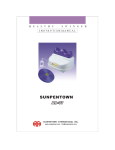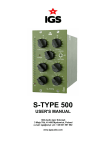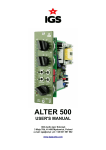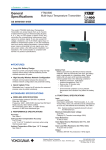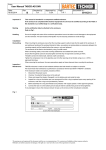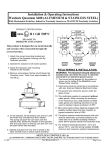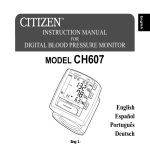Download Safety Report Summarization - The Original Ion Cleanse® Footbath
Transcript
SPRACKLING CONSULTING COMPANY 324 Peery Parkway Golden, Colorado 80403 Safety Report Summarization Electronic Detoxification System Life Detoxify Health Device This report is a summary of the Compliance Integrity Services Product Safety Evaluation Findings Letter. The tests were performed on April 7, 2007 on the Life Detoxify Health Device, Electronic Detoxification System. Compliance Integrity Services stated that “the Standard IEC 60335-1 was used as a Guide and there is no Part 2 Particular Standard that covers the subject ‘Electronic Detoxification System’.” This report also summarizes the Emissions testing performed by EMC Integrity. This device was evaluated in accordance with EN 55011,”Limits and methods of measurement of radio disturbance characteristics of industrial scientific and medical (ISM) radio-frequency equipment”. The device tested failed various safety tests and was non-compliant in other areas. This test device failed the Marked Mains Supply Input vs. Actual Mains Supply Input, and the Emissions test. It is missing required designations on the test device and has some wiring and grounding issues. The test results and findings are further explained below. Mode of Usage This system is described as a “Spa Cleanse” and “Ionic Unit” with a Main Unit, one submersible array (“Ionhead Electrode Plate”), one wristband (“Wristlet”), and a waist belt (“Bamboo Charcoal Waist Belt”). The manual also lists some therapeutic medical uses that may not be FDA approved. The instructions for this product also recommend using the salt content of the bath to maintain the voltage between 12 and 18 Vdc and the current between 1.7 and 2.1 A. Adding salt to the bath increases the current carrying capacity of the saline solution. Although these values are indicated on the display of the test device, during testing they were found to be as much as 50% off for the voltage and 10% off for the current. During testing it was observed that the DC output circuit is interrupted unless a low impedance circuit is detected between the wristband and the submersible array, and the output was shut off when the output current became higher than 2.6 A. Equipment Rating (Marked Mains Supply Input vs. Actual Mains Supply Input) Power equipment is rated for specific voltages and currents. It is important to design equipment so that the power rating for any component is not exceeded. If the power rating for a component is exceeded it can overheat and become a fire hazard or potential shock hazard as the equipment may fail. This test device failed this portion of the test, because it did not have marked Mains Supply Input Rating and there is no clear documentation that states what the maximum output voltage or maximum output current is for the components of this device. The test device did not overheat during testing. Electrical Current in the Saline Solution (Accessibility of Hazardous Voltages) It is important to avoid personal exposure to hazardous voltages and currents. The test device uses 16.2 Vdc which is considered an Extra Low Voltage to minimize electrical shock. Current and voltage combine to cause electrical shock so this test looks at both factors to determine an unsafe level for humans. The US Standards set limits for voltages exceeding 21.2 Vdc at 2 mA (miliamperes). The International Standards do not set limits for voltages under 42.4 Vdc. Life Detoxify Health Device Page 1 of 3 SPRACKLING CONSULTING COMPANY 324 Peery Parkway Golden, Colorado 80403 The DC Output circuit of the test device is considered accessible, because the user can come in wet contact with the electrodes in the Ion-head Electrode Plate and the Wristlet. It was noted that the electrodes in the array are enclosed and are not accessible (using the test finger probe) to the User. However because they are placed in a saline solution this circuit is considered to be “accessible” for testing purposes. This test performed between the accessible electrodes in the Ion-head Electrode Plate passed for both US and International Standards. This test performed between the accessible electrodes in the Ion-head Electrode Plate and the Wristlet passed for both US and International Standards This test performed between the accessible Ion-head Electric Plate and electrical ground passed for both US and International Standards. Electrical ground can be any conductive surface at electrical ground such as plumbing including bathroom faucets. (Leakage Current) The electronic detoxification system is designed to generate low levels of direct current (DC power) that flows through the user’s body accessible through placing body parts in the saline bath with the Spa Module. Leakage current represents currents that should not be present and could result in electrical shock by touching two accessible components of the test device. Some medical devices are regulated to permit electrical current flow, but this device is not certified as a medical device. The United States and International standards require exposure to this electrical current to be limited. The device tested passed this test for both US and International Standards. This device uses 16.2 Vdc. The International Standards do not set limits for voltages under 42.4 Vdc and the US Standards do not set limits for voltages under 21.2 Vdc. This limitation of leakage current also applies to alternating current (AC or wall power). The test device passed this test for both US and International Standards. Output Short Circuit A short circuit is the connection between two nodes of an electrical circuit that are meant to be at different voltages resulting in a large electrical current. It is important that the output circuits or devices such as the heating waistband and Ion-head Electric Plate are protected against short circuits using fuses or circuit breakers to prevent potential shock and fire hazards. The device tested complied with this test for the Ion-head Electric Plate because it did not overheat and the fuse and thermal protection worked. This test device did not comply with this test for the heating waistband. The test was stopped before the device was damaged. Transformer Tests The following three tests are run specifically on the transformer used in this device. A transformer is a device that transfers electrical energy from one circuit to another by magnetic coupling without requiring relative motion between its parts. In this case the transformer is used to reduce the voltage from 120 V to 16 V. It is important that transformers work correctly otherwise they can be a potential shock and/or fire hazard. Power transformers are typically third party certified for safety and operation such as Underwriter’s Laboratory or UL. The transformer in the device tested did not appear to have third party cerification. (Dielectric Strength) Life Detoxify Health Device Page 2 of 3 SPRACKLING CONSULTING COMPANY 324 Peery Parkway Golden, Colorado 80403 Dielectric strength is the electric field strength that the transformer can withstand without experiencing failure of its insulating properties. If the insulative properties of the transformer fail the transformer will not function and is a potential fire and shock hazard. The test device complied with this test. (Protective Earthing Resistance Measurement) A protective earth connection ensures that all exposed conductive surfaces are at the same electrical potential as the surface of the Earth. It is important for a transformer to have a protective earth ground to avoid the risk of electrical shock if a person touches a device in which an insulation fault has occurred. The device tested complied with this test. (Short Circuit) A short circuit is the connection between two nodes of an electrical circuit that are meant to be at different voltages resulting in a large electrical current. It is important that equipment such as transformers is protected against short circuits using fuses or circuit breakers. The device tested complied with this test, for the transformer, because it did not overheat and the fuse and thermal protection worked. Construction Deficiencies The test device is a potential fire hazard, because a shaving of the plastic enclosure of the test device indicated that the material is not the self-extinguishing type. The plastic enclosure was also cracked. There are standards in place for wiring and grounding to prevent injury both during use and during servicing of a device. The test device did not follow standards for wiring and grounding. Some of the grounding and wiring issues can potentially result in electrical shock. During testing this device was found to be erratic and unreliable. Although the unit would self-recover without damage, the unit load would change drastically and the unit would lock up not producing an output. The Waistband heating control also locked up and over-heated, requiring the device to be turned off to reset it. Non-Standard or Non-Existent Power Markings It is important to designate the ratings of electrically powered equipment to prevent injury and unsafe use of a product. It is required by the US standards to have the mains supply electrical rating marked on a device. It is also required that the Control Unit include markings to refer to the User Manual for instructions on the safe use of the equipment. The test device did not have markings designating the correct electrical ratings, nor safety information. The test device also did not have any reference to the manufacturer on the Main Unit or in the Operating Instructions. Emissions Testing An Emissions test was performed on this device to determine its electromagnetic emissions. Devices have to be designed in a way that their electromagnetic emissions or disturbances do not interfere with the operation of radio and telecommunication and other devices in accordance with their purpose. The test device failed this test. Life Detoxify Health Device Page 3 of 3



